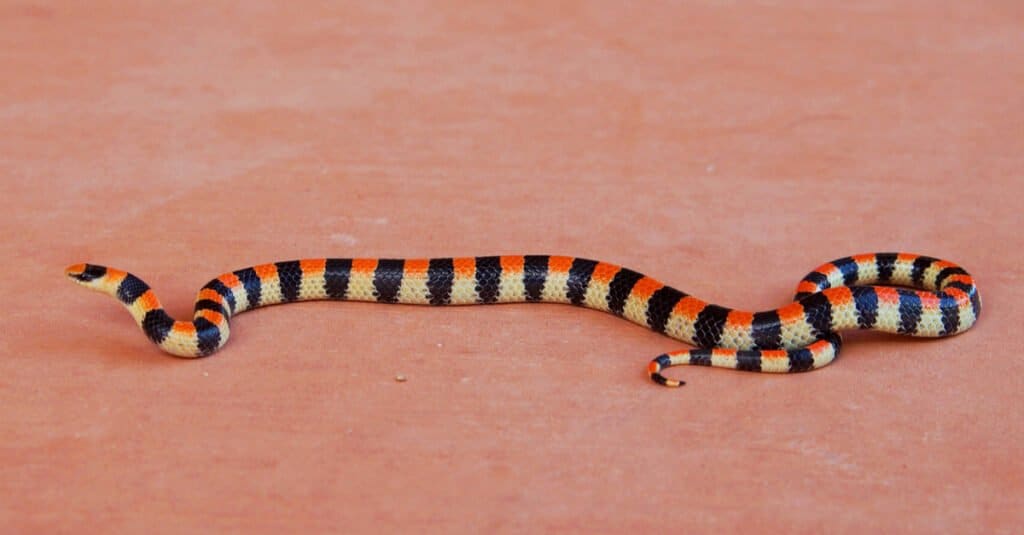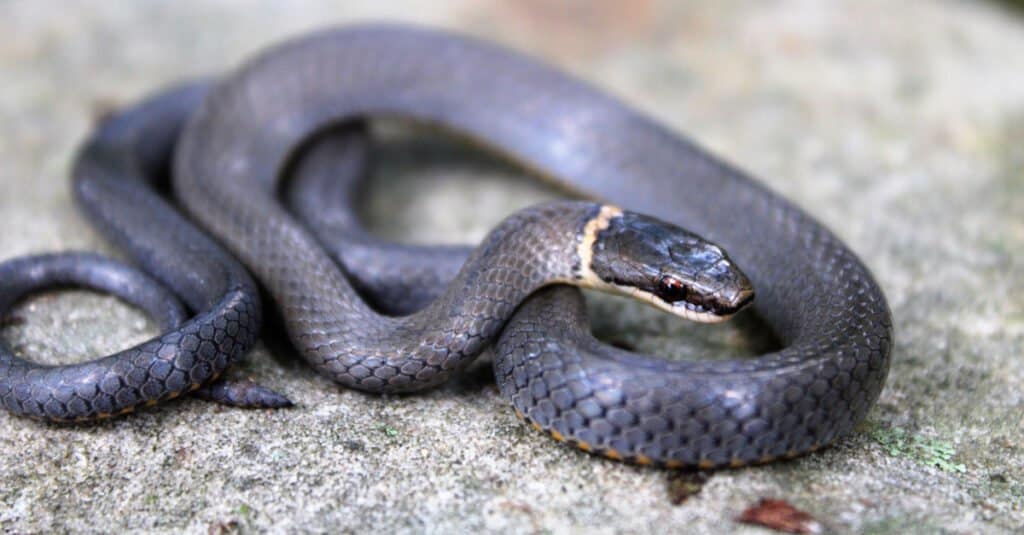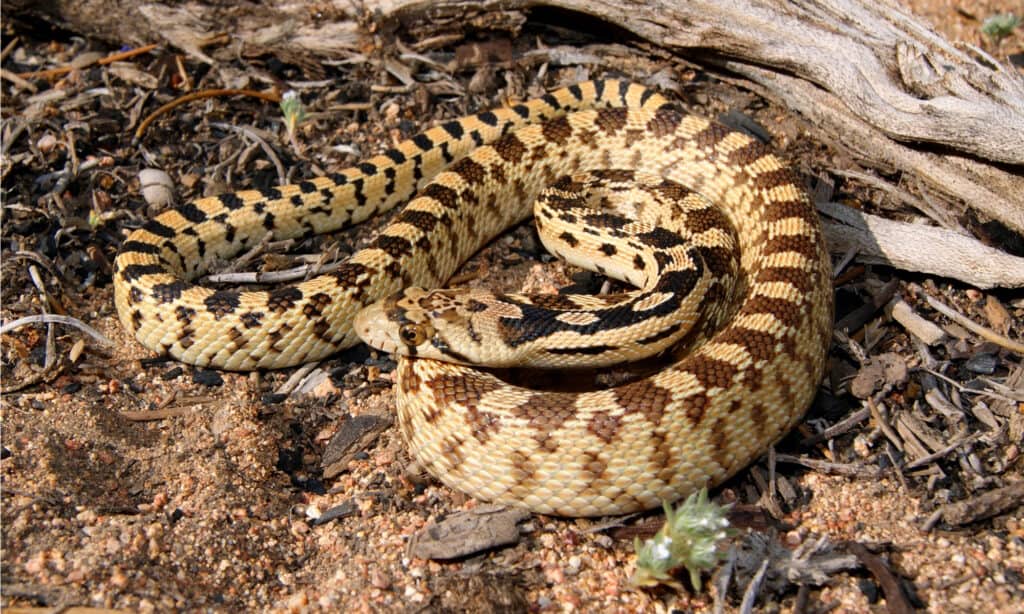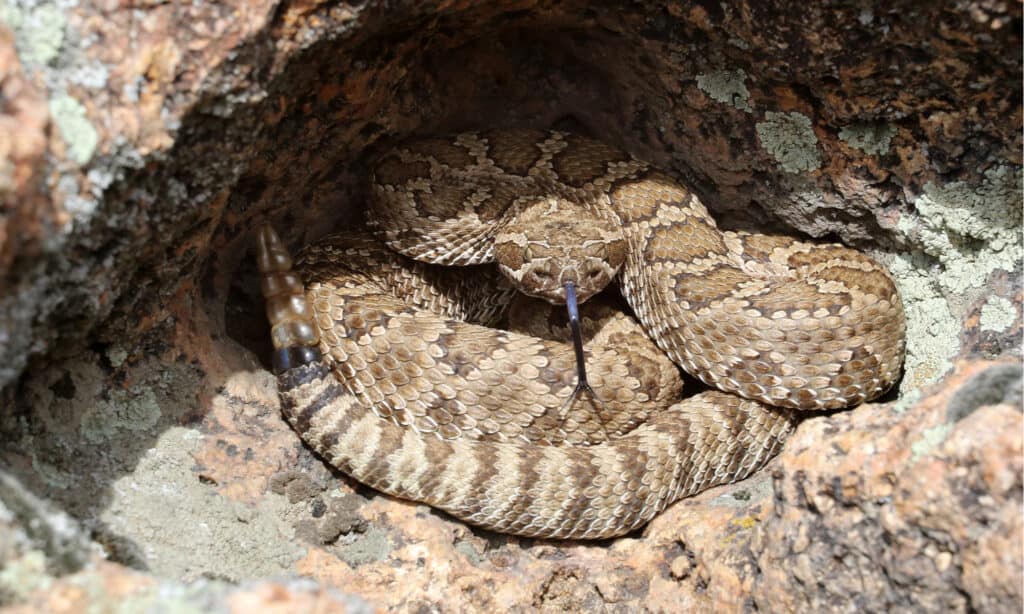Located in southwestern Utah, Zion National Park is one of the most unique geographical locations in the United States. The park resides at the intersection of the Colorado Plateau, the Great Basin, and the Mojave Desert. This unique melding of geological formations forms the basis for the park’s incredible sandstone canyons and wild beauty. Every year, more than 3.5 million people visit the park to appreciate its scenic vistas and the wildlife that lives there.
The ecology of the 229 square mile park varies wildly depending on the location. Inside the park, you can find four distinct ecosystems: desert, riparian wetland, coniferous forest, and woodland. Numerous animals make their home in the park, including 289 bird species, 75 mammals, and 32 reptiles. The park contains at least 14 species of snake, including 1 venomous species. Keep reading to learn more about the snakes inside Zion National Park!
The 14 Snakes Inside Zion National Park
Most people don’t realize how many snake species call Zion National Park home. It’s easy to miss out on these amazing reptiles, as most spend their time hiding inside burrows underground or hidden under rocks, logs, or foliage. Snakes rely on camouflage and other biological adaptations to help them hide from predators and sneak up on prey. Given their secretive nature and these built-in adaptations, you’d hardly ever know if you encountered a snake in the park unless it slithered right into your lap. Thankfully, only one snake in the park possesses venom potent enough to pose a danger to humans. All that said, let’s take a look at the 14 snakes you can find in Zion National Park:
- Western Terrestrial Garter Snake – Thamnophis elegans
- Ring-necked Snake – Diadophis punctatus
- Sinaloan Nightsnake – Hypsiglena torquate
- Striped Whipsnake – Masticophis taeniatus
- Coachwhip – Masticophis flagellum
- Western Lyre Snake – Trimorphodon biscutatus
- Southwestern Blackhead Snake – Tantilla hobartsmithi
- Ground Snake – Sonora semiannulata
- Western Patch-nosed Snake – Salvadora hexalepis
- Great Basin Gopher Snake – Pituophis catenifer deserticola
- California Kingsnake – Lampropeltis californiae
- Common Kingsnake – Lampropeltis getula
- Arizona Mountain Kingsnake – Lampropeltis pyromelana
- Great Basin Rattlesnake – Crotalus lutosus
Common Snakes
Ground Snake

Ground snakes prefer dry, arid climates with plenty of rocks and loose soil.
©Matt Jeppson/Shutterstock.com
The western ground snake also goes by the name the common ground snake or variable ground snake. It also goes by the name miter snake due to the marking on its head, which resembles a bishop’s hat, or miter. Aside from this pattern, its markings can vary. Some ground snakes feature black bands, while others have brown or orange stripes. On the other hand, some ground snakes sport no markings at all. They range in color from orange to red to brown. Most specimens measure between 8 and 19 inches long. Ground snakes prefer dry, arid climates with plenty of rocks and loose soil to make their burrows. They tend to hide underground during the day and emerge at night to hunt for food. Their diet consists mostly of invertebrates, including insects, spiders, and scorpions.
Common Kingsnake

Common kingsnakes hunt by clamping down on the jaws of their prey.
©iStock.com/JasonOndreicka
Also known as the eastern kingsnake or chain kingsnake, the common kingsnake is a harmless snake found throughout the United States and Mexico. Common kingsnakes come in a wide range of sizes. Smaller specimens can measure as little as 36 inches. Meanwhile, larger common kingsnakes can grow in excess of 60 inches. They also vary considerably in weight, from as little as 10.1 ounces to over 80 ounces. In terms of color, they appear either glossy blue, black, or dark brown. Most feature whitish chain-like rings, hence the name chain kingsnake. Common kingsnakes can thrive in myriad habitats, woodland, desert, riparian zone, swamps, and mountains. That said, they tend to prefer open grassland. They can act extremely territorial – especially the males – when another snake encroaches upon their territory. Given that snakes make up the majority of their diet, they hunt by clamping down on the jaws of their prey.
Striped Whipsnake
The striped whipsnake is another snake common to Zion National Park. Most striped whipsnakes measure 30 to 72 inches long. The dorsal side appears dark brown, gray, or black and sometimes has an olive or bluish hue. It features a cream to white-colored stripe down the side crossed by a dashed or solid black line. Meanwhile, the ventral side usually looks mostly cream or yellow aside from a light pink patch near the tail. The striped whipsnake gets its name from its quick, whiplike tail. These alert, fast-moving snakes chase their prey during the day. You can find them in various habitats, including grasslands, shrublands, canyons, and forests. They rely on their speed to catch prey which includes lizards, birds, frogs, insects, and other snakes.
Most Colorful Snakes
Arizona Mountain Kingsnake

Arizona mountain kingsnakes feature alternating black-banded red and cream stripes.
©Rusty Dodson/Shutterstock.com
The Arizona mountain kingsnake, or Sonoran mountain kingsnake, is another member of the kingsnake family. It can grow up to 36 inches long from nose to tail. Arizona mountain kingsnakes feature alternating black-banded red and cream stripes. They inhabit forests and woodlands and live in close proximity to streams or springs. During the day, you can often find them sunning themselves on rocks or logs. Their diet consists mostly of rodents, small birds, and lizards.
Ring-necked Snake

The ring-necked snake is a nocturnal snake.
©Tucker Heptinstall/Shutterstock.com
Ring-necked snakes live throughout much of North America. They measure between 10 and 18 inches long, depending on the region where they live. The dorsal side ranges in color from brown to olive to back to gray. That said, they sport a characteristic bright red, orange, or yellow ring around the neck, hence their name. When threatened, they typically curl up their tails to reveal their bright red-orange ventral side. Ring-necked snakes favor areas with plenty of cover, such as woodlands near rocky hillsides. These secretive, nocturnal snakes rarely emerge during the daytime. At night, they emerge from their burrows to hunt salamanders, frogs, and worms. They use venom and constriction to subdue their prey, although their venom is harmless to humans.
Largest Snake
Great Basin Gopher Snake

You can find Great Basin gopher snakes in woodlands, grasslands, deserts, and riparian areas.
©Matt Jeppson/Shutterstock.com
The Great Basin gopher snake ranks as the largest snake inside Zion National Park. While most specimens measure around 4.5 feet, they can grow up to 5.75 feet long. The dorsal side looks light brown or yellow and features dark brown or black spots. Meanwhile, the ventral side appears creamy-colored and sports small, dark markings. Great Basin gopher snakes typically live for 12 to 15 years, but the oldest specimen on record lived over 33 years. You can find Great Basin gopher snakes in woodlands, grasslands, deserts, and riparian areas. They are excellent burrowers, climbers, and swimmers. People often mistake them for Great Basin rattlesnakes due to their habit of hissing and shaking their tails when threatened. They prey primarily on small mammals such as gophers, hence their name. However, they will also consume lizards and small birds when available.
Venomous Snake
Great Basin Rattlesnake

Great Basin rattlesnakes live in dry, barren habitats that feature plenty of rocks and boulders for them to hide under.
©Randy Bjorklund/Shutterstock.com
The Great Basin rattlesnake represents the sole venomous snake species found in Zion National Park. Adults measure between 26 and 49 inches long, with females measuring smaller than males. Most specimens appear gray, brown, olive, or yellow with brown or black splotches. The pattern tends to fade or appear more uniform with age. Great Basin rattlesnakes live in dry, barren habitats that feature plenty of rocks and boulders for them to hide under. Their diet consists of small birds, reptiles, amphibians, and mammals. People often encounter them when hiking on trails. When threatened, they may shake their tails, which produces a distinctive rattling sound.
How to Avoid a Rattlesnake
If you don’t want to get bit by a snake, the best thing you can do is stay far away from them. While rattlesnakes rarely bite, you should take every precaution possible to avoid getting bitten. Rattlesnakes can’t regulate their body temperature, so they look for open sunny spots to warm themselves after cool nights. As temperatures rise, rattlesnakes will look for shady spots out of the sun to cool down. Avoid walking off trail or in areas with tall grass or shrubs where rattlesnakes may be resting.
If you encounter a rattlesnake on a trail, either back away or simply walk around the snake. Chances are that it won’t come after you. Like all snakes, rattlesnakes don’t have external ears; instead, they “hear” by sensing vibrations using their inner ear. You can try stomping the ground near a snake to get it to move out of the way. Do not throw anything or try to intimidate a snake. This may make the snake act aggressively and make it more inclined to bite.
What to Do if You Get Bit by a Rattlesnake
In the event that a rattlesnake bites you, do not panic. Once bitten, your goal should be to get to the nearest hospital as soon as possible so you can get a dose of antivenom. Most rattlesnake bites are not fatal, so you should have time to walk or bike out of the park and get treatment. If the bite worsens, try to immobilize the affected part or wrap the wound with a bandage or gauze. Try to call 911 if you have cell service and can not get to a vehicle or nearby recreational facility off-trail. In no circumstance should you:
- Cut into the wound and try to “suck out” the venom
- Ingest alcohol, medication, or caffeine
- Apply ice to a snakebite
- Use a homemade or amateur snakebite kit
- Apply an electric shock to the affected area
Conclusion
Zion National Park contains thousands of snakes, but most do not pose a threat to humans. The vast majority of snakes want to mind their own business, but it’s wise to give any snakes you encounter a wide berth. Even harmless snakes may still bite if threatened or startled. Avoid handling or harming snakes you encounter, as snakes serve a vital role in maintaining the health of an ecosystem. The next time you visit Zion National Park, see if you can spot one of the snakes on this list!
The photo featured at the top of this post is © Matt Jeppson/Shutterstock.com
Discover the "Monster" Snake 5X Bigger than an Anaconda
Every day A-Z Animals sends out some of the most incredible facts in the world from our free newsletter. Want to discover the 10 most beautiful snakes in the world, a "snake island" where you're never more than 3 feet from danger, or a "monster" snake 5X larger than an anaconda? Then sign up right now and you'll start receiving our daily newsletter absolutely free.
Thank you for reading! Have some feedback for us? Contact the AZ Animals editorial team.






